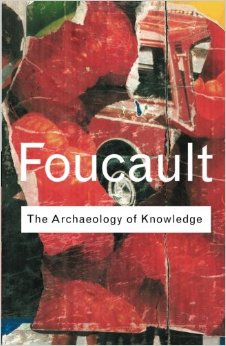This blog post will focus on tips for getting on with theoretical writing. Foucault’s works are
![By Lucas Barroso Félix (Own work) [CC BY-SA 4.0 (http://creativecommons.org/licenses/by-sa/4.0)], via Wikimedia Commons](https://www.booksaresocial.com/wp-content/uploads/2015/11/Michel_Foucault.jpg)
dense and sometimes hard to use, but the benefits of wrapping your head around the Archaeology and Genealogy are innumerable when working in transmedia settings.
For the past 10-11 months, I’ve been working on writing the theory chapter for my thesis. (which you can find more about and even get involved in here) I’ve been focussing on Foucault and McLuhan, reading just about everything I can get my hands on that looks at their works: The Archaeology of Knowledge and Understanding Media and The Medium is the Massage, respectively. Finally, surrounded by cats in a lovely spot near the centre of Oxford, I took over a kitchen table and spent a full week writing my chapter.
And then I re-wrote it.
Then one of my advisers, herself massively talented in teaching the methods of using Foucault, gave me two bits of the best advice for working with him that I have yet received for using any theory: think of it as an upside down triangle, going from big to specific; and stop writing like Foucault when writing Foucault.
Yes, these seem to be really intuitive bits of advice, but so easily forgotten when you delve into the deep end of any theoretical framing and get really excited about understanding it and applying it.
Go BIG, then go small
In writing Foucault in my first draft I structured my chapter much like Foucault structures his Archaeology of Knowledge, going from smallest parts (the statement, and the bits that make it up), moving slowly outward. This seemed like the most obvious way to go about using Foucault’s work to expand on my own, and so I went through considering what the statements of the book are, its objects, associated fields, etc., and finally the archive.
This worked quite well in the first draft, allowing me to really see how my ideas were using Foucault’s tool-box, but it did exactly what every Essay Writing 101 student is taught not to do: it took an idea and went bigger with it, when you should be doing the opposite.
I used to teach tutorials in English Literature at the University of Edinburgh and part of what we did was teach the students the best way to take an idea for their essay and to hone the finer points, to draw out the details and nuances of their work. If they thought that Christina Rossetti’s “Goblin Market” was a feminist anthem of her time, I told them to show me in the language, structure, and historical background if that was apt. And, here I was doing the opposite thing and going outward with my own PhD work!
Essentially I needed to turn my entire chapter upside down. One of the ways to go about this is to borrow from Carol Snyder and:
- Identify the objects of classification – we don’t have to use all the tools, we can choose to look at three things and not five others
- Identify what the classification excludes – why did we choose not to include x, y, and z and why is that important in the way it changes the power dynamic in the overall classification you are looking into
- Identify the human subjects who devise or use the classification – who does the classification serve and who does it exclude? Why are these people or groups able to make these statements and how does that too alter the power dynamic?
- Locate the classification in time – using a “slice of history” (Foucault, 1989, pp 281) we can put our own parametres on our classification
- Locate the classification in space – Where did it come from? Did the rise of the citizen author come from the advent of ebooks and Kindle? or was it already well-established on the fan-fiction websites and in snail-mail story rings?
These bullet points are a good way to start thinking of using and writing Foucault as a way to frame a study in publishing and media. The next step, also simple sounding, is really quite useful and harder than you would think.
Write with your own voice
“Stop writing like MF and write like MJ”. That’s one of the points that was driven home to me in my last meeting. I do tend to take on the style of whatever I am writing about. In reading loads of articles on copyright law, I started to write like my friends who are lawyers; the same thing was happening with writing Foucault (perhaps this was a knack/vice I picked up in my previous work in creative writing where one often teaching students to emulate as learning).
The solution? Re-write my chapter without using any quotes from Foucault at all, forcing me to look for ways to put his theories into my own words, explaining them fully as they relate to new definitions of the book, the slush pile and social media.
This was an excellent exercise, one that I fully suggest anyone who is trying to write about a theorist’s work do, even as an only academic exercise. The problem I was having was that even in taking out the direct quotations, I was still sounding Foucauldian. To combat this, I began to read Convergence Culture by Henry Jenkins, which is both useful in my research, and carries a good sense of writing from one’s own authority, which I need to better adapt to my writing. Works like this and Michael Bhaskar’s The Content Machine are great for finding the style that complements the subject and allows for the author’s own voice and command of the topic come through.
I understand Foucault’s work and how to apply it to a variety of classifications and situations, but I need to avoid telling readers how I understand it, and to use it as a way of working with my topic to present understanding through Foucault. Easier said than done, but achievable, perhaps, in re-write number 4.
Next time I’ll look at what it takes to get the gist of Foucault’s Archaeology and why it’s so good for media and transmedia works.
Snyder, Carol. 1984. “Analyzing Classifications: Foucault for Advanced Writing.”
National Council of Teachers of English. Vol. 35, No. 2. May, 1984, pp209-216. Available at: http://www.jstor.org/stable/358097
See also:
Kendall and Wickham. Using Foucault’s Methods, 2003. Sage.
Morgan, Angela. “Discourse Analysis: An Overview for the Neophyte Researcher”. Journal of Health and Social Care Improvement. May, 2010.

